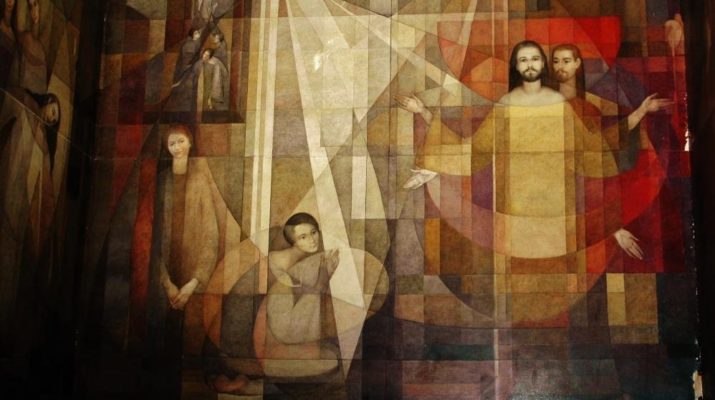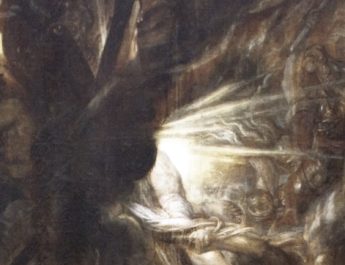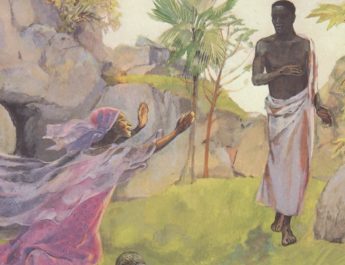John 20:1-18
Easter, A20
BibleHub
1 EarlyA on the first day of the week,B while it was still dark,C MaryD MagdaleneE came to the tombF and sawG that the stone had been removedH from the tomb.
Notes on verse 1
A “early” = proi. 12x in NT. From pro (before, earlier than, ahead, prior). This is early, at dawn, during the daybreak watch.
B “week” = sabbaton. From Hebrew shabbath (sabbath); from shabath (to rest, stop, repose, cease working; by implication, to celebrate). This is the sabbath. It can also be used as shorthand for a week i.e. the time between two sabbaths.
C “dark” = skotia. 16x in NT. From skotos (darkness literal or figurative – as moral or spiritual darkness, sin and what comes from it; obscurity); from skia (shadow, thick darkness, outline; figurative for a spiritual situation that is good or bad). This is darkness or dimness. Figuratively, it can be a spiritual darkness. This is obscurity in a literal or figurative sense.
D “Mary” = mariam.From Hebrew Miryam (Aaron and Moses’s sister); from marah (to be contentious, rebellious, bitter, provoking, disobedient; to be or make bitter or unpleasant; figuratively, to rebel or resist; causatively to provoke). This is Miriam or Mary.
E “Magdalene” = Magdalene. 12x in NT. From Magdala (Magadan, a place near the Sea of Galilee); perhaps from Aramaic migdal, see also Hebrew migdal (tower); from gadal (to grow, grow up, be great). This is from Magdala.
F “tomb” = mnemeion. From mousikos (to remember); from mneme (memory or mention); from mnaomai (to remember; by implication give reward or consequence); perhaps from meno (to stay, abide, wait, endure). This is properly a memorial – a tomb, grave, monument.
G “saw” = blepo. This is literally to see – it is primarily used in the physical sense. However, figuratively it can be seeing, which includes attention and so to watchfulness, being observant, perceiving, and acting on the visual information. It can also mean beware.
H “removed” = airo. This is to lift up in a literal or figurative sense. So, it could mean to lift, carry, or raise. It could also imply lifting something in order to take it away or remove it. Figuratively, this can be used for raising the voice or level of suspense. It can mean sailing off as raising the anchor. It can also correspond to a Hebrew expression for atonement of sin (lift/remove sin).
2 So she ranI and went to SimonJ PeterK and the other disciple,L
Notes on verse 2a
I “ran” = trecho. 20x in NT. To run, make progress, rush. This is running like an athlete in a race. Figuratively, to work quickly towards a goal in a focused way.
J “Simon” = simon.From Hebrew Shimon (Simon – Jacob’s son and his tribe); from shama (to hear, often implying attention and obedience). This is Simon, meaning “he who hears.”
K “Peter” = petros. Related to petra (large rock that is connected and or projecting like a rock, ledge, or cliff; can also be cave or stony ground). This is Peter, a stone, pebble, or boulder.
L “disciple” = mathetes.From matheteuo (to make a disciple of); from manthano (to learn key facts, gain knowledge from experience; generally implies reflection as part of the learning process); from math– (thinking things through). This is a disciple, learner, or student. It is where we get “mathematics” from.
the one whom JesusM loved,N and said to them, “They have takenO the LordP out of the tomb, and we do not knowQ where they have laid him.”
Notes on verse 2b
M “Jesus” = iesous.From Hebrew Yehoshua (Joshua, the Lord is salvation); {from YHVH (proper name of the God of Israel; the self-existent and eternal one); {from havah (to become) or from hayah (to come to pass, become, be)} + yasha (to deliver, defend, help, preserve, rescue; properly, to be open, wide or free, which implies being safe. So, in a causative sense, this is to free someone). This is Jesus or Joshua in Greek – the Lord saves or the Lord is salvation.
N “loved” = phileo. From philos (dear, beloved, a friend, an associate; friendship with personal affection, a trusted confidante; love from personal experience with another person). This is friendship love and fondness with personal attachment.
O “taken” = airo. Same as “removed” in v1. See note H above.
P “Lord” = kurios.From kuros (authority, supremacy). This is a respectful address meaning master or sir. It refers to one who has control or power greater than one’s own. So, it was also applied to God and Jesus as Master or Lord.
Q “know” = eido. This is to know, consider perceive, appreciate, behold, or remember. It means seeing with one’s eyes, but also figuratively, it means perceiving – seeing that becomes understanding. So, by implication, this means knowing or being aware.
3 Then Peter and the other disciple set out and went toward the tomb. 4 The two were running together, but the other disciple outranR Peter and reached the tomb first. 5 He bent down to look inS and saw the linen wrappings lying there, but he did not go in.
6 Then Simon Peter came, followingT him, and went into the tomb. He sawU the linen wrappings lying there, 7 and the clothV that had been on Jesus’ head, not lying with the linen wrappings but rolled up in a place by itself.
Notes on verses 3-7
R “outran” = protrecho + tachion. Related to “ran” in v2. 2x in NT. From pro (before, earlier than, ahead, prior) + trecho (see note I above). This is run ahead, outstrip, precede. Tachion is 4x in NT. From tachus (quickly, promptly; without unreasonable delay). This is more rapidly, more swiftly, without unnecessary delay.
S “bent down to look in” = parakupto. 5x in NT. From para (by, beside) + kupto (to stoop, bend forward, bow one’s head); perhaps from kuma (wave, billow, curve, bend); from kuo (to swell as one pregnant). This is to bend beside or stoop. To bend over to peer into.
T “following” = akoloutheo. From a (with, fellowship, union) + keleuthos (road, way). This is to accompany or follow someone, especially the way a disciple does.
U “saw” = theoreo. From theaomai (to behold, look upon, see, contemplate, visit); from thaomai (to gaze at a spectacle; to look at or contemplate as a spectator; to interpret something in efforts to grasp its significance); from theoros (a spectator or envoy). This is gazing, beholding, experiencing, discerning. It is looking at something to analyze it and concentrate on what it means. This is the root of the word “theatre” in that people concentrate on the action of the play to understand its meaning.
V “cloth” = soudarion. 4x in NT. From Latin sudarium (sweat cloth) This is a napkin, face cloth, or handkerchief. It can be used as a towel to wipe sweat from the face or a cloth for the head of a corpse.
8 Then the other disciple, who reached the tomb first, also went in, and he sawW and believed;X 9 for as yet they did not understand the scripture,Y that he mustZ riseAA from the dead. 10 Then the disciples returned to their homes.BB
Notes on verses 8-10
W “saw” = horao. To see, perceive, attend to, look upon, experience. Properly, to stare at and so implying clear discernment. This, by extension, would indicate attending to what was seen and learned. This is to see, often with a metaphorical sense. Can include inward spiritual seeing.
X “believed” = pisteuo. From pistis (faith, faithfulness, belief, trust, confidence; to be persuaded or come to trust); from peitho (to have confidence, urge, be persuaded, agree, assure, believe, have confidence, trust). This is to believe, entrust, have faith it, affirm, have confidence in. This is less to do with a series of beliefs or doctrines that one believes and more to do with faithfulness, loyalty, and fidelity. It is trusting and then acting based on that trust.
Y “scripture” = graphe. From grapho (to write). This is literally writing, a document. In the New Testament, this is always used for scripture.
Z “must” = dei. From deo (to tie, bind, compel; declare unlawful). This is what is necessary or proper. It is what is needed or what one should do – a duty or something inevitable. This refers to something absolutely necessary.
AA “rise” = anistemi. From ana (upwards, up, again, back, anew) + histemi (to make to stand, place, set up, establish, appoint, stand by, stand still, stand ready, stand firm, be steadfast). This is to raise up, rise, appear. It is to stand up literally or figuratively. Can also mean to resurrect.
BB “homes” = hautou. 9x in NT. Related to heautou (of himself, herself, or itself); from autos (he, she, it, they, them). This is his own, her own, their own, or each other.
11 But Mary stoodCC weepingDD outside the tomb. As she wept, she bent over to look into the tomb; 12 and she saw two angelsEE in white,FF sitting where the bodyGG of Jesus had been lying, one at the head and the other at the feet.
Notes on verses 11-12
CC “stood” = histemi. Related to “rise” in v9. See note AA above.
DD “weeping” = klaio. This is to weep, lament, or sob. It is weeping aloud.
EE “angels” = aggelos. Probably from ago (to lead, bring, carry, guide) + agele (flock, herd, drove) [also from ago (see above)]. This is angel or messenger. Properly, it is one sent with news or to perform a specific task. This messenger can be human or an angel from heaven. More commonly, it is used for angels in the New Testament.
FF “white” = leukos. Related to luke (light). This is bright, white, or brilliant.
GG “body” = soma. Perhaps from sozo (to save, heal, rescue); from sos (safe, well, rescued). This is body or flesh. It can be body in a literal or figurative sense (as the body of Christ). This is where the word “somatic” comes from.
13 They said to her, “Woman,HH why are you weeping?”
She said to them, “They have taken away my Lord, and I do not know where they have laid him.” 14 When she had said this, she turnedII around and saw Jesus standing there, but she did not know that it was Jesus.
15 Jesus said to her, “Woman, why are you weeping? Whom are you looking for?”JJ
SupposingKK him to be the gardener,LL she said to him, “Sir, if you have carried him away, tell me where you have laid him, and I will take him away.”
Notes on verses 13-15
HH “woman” = gune. Perhaps from ginomai (to come into being, to happen, become, be born; to emerge from one state or condition to another; this is coming into being with the sense of movement or growth). This is woman, wife, or bride. This is where the word “gynecologist” comes from.
II “turned” = strepho. From trope (turning, shifting, a revolution; figuratively, a variation); from trepo (to turn). This is to turn, change, turn back, be converted; to turn around completely to take the opposite path or a completely different one.
JJ “looking for” = zeteo. This is to seek, search for, desire. It is searching for something by inquiring or investigation. It can be seek in a literal or figurative sense. There is a Hebrew figure of speech “to seek God’s face” so it can also mean to worship God. Alternately, you could seek someone’s life i.e. plot to kill them.
KK “supposing” = dokeo. From dokos (opinion). This is to have an opinion, seem, appear, think, suppose. It deals with a personal judgment. This is the root of the word “doxology.”
LL “gardener” = kepouros. 1x in NT. From kepos (garden with trees or herbs) + ouros (watcher). This is literally garden-keeper.
16 Jesus said to her, “Mary!”
She turned and said to him in Hebrew,MM “Rabbouni!”NN (which means Teacher).OO
Notes on verse 16
MM “in Hebrew” = hebraisti. 7x in NT. 7x in NT. From Hebrais (Hebrew language, Aramaic); from Eber (Heber); from Hebrew Eber (the region beyond; Eber, the name of several Israelites including a descendant of Shem); from abar (to pass over, pass through, or pass by; cross over or to alienate; used for transitions). This is Hebrew, perhaps meaning a descendant of Eber. This is in Hebrew or in Aramaic.
NN “rabbouni” = rhabbouni. 2x in NT. From rhabbi (a title of respect for a teacher-scholar; literally, great one or honorable sir; also my master or my teacher); from Hebrew rab (chief); from rabab (to be many, increase, multiply). This is Rabbi, Lord, my master, my teacher in Aramaic.
OO “teacher” = didaskalos. From didasko (to teach, direct, instruct, or impart knowledge; in the New Testament, almost always used for teaching scripture); from dao (to learn). This is teacher or master.
17 Jesus said to her, “Do not hold onPP to me, because I have not yet ascended to the Father. But goQQ to my brothersRR and say to them, ‘I am ascending to my Father and your Father, to my GodSS and your God.’”
18 Mary Magdalene went and announcedTT to the disciples, “I have seen the Lord”; and she told them that he had said these things to her.
Notes on verses 17-18
PP “hold on” = haptomai. From hapto (to touch, handle, kindle, lay hold of). This is a touch that has an impact on what is being touched – it has an influence on the recipient so that the recipient is changed.
QQ “go” = poreuomai. From poros (ford, passageway). This is to go, travel, journey, or die. It refers to transporting things from one place to another and focuses on the personal significance of the destination.
RR “brothers” = adelphos. From a (with, community, fellowship) + delphus (womb). This is a brother in a literal or figurative sense. It is also used of another member of the Church.
SS “God” = theos. From Proto-Indo-European origins, meaning do, put, place. This is God or a god in general.
TT “announced” = apaggello. Related to “angels” in v12. From apo (from away from) + aggello (to announce, report); {from aggelos (see note EE above)}. This is to declare, announce, bring news. It places the emphasis on the source that shapes the announcement.
Image Credit: Painting from the Church of Saint Magdalene in Esplugues in Barcelona.




